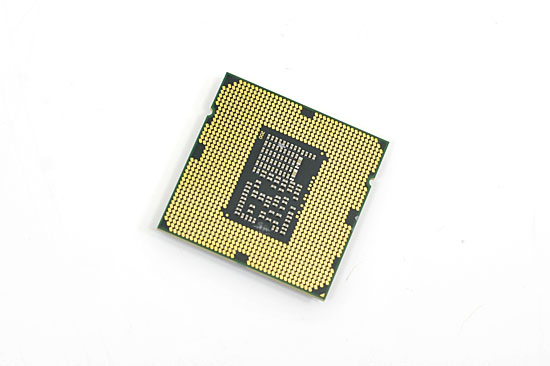The Clarkdale Review: Intel's Core i5 661, i3 540 & i3 530
by Anand Lal Shimpi on January 4, 2010 12:00 AM EST- Posted in
- CPUs
Memory Performance - Not Very Nehalem
Let’s start at the obvious place, memory performance. Nehalem moved the memory controller on-die, but Clarkdale pushes it off again and over to an on-package 45nm graphics core.

To make matters worse, the on-package chipset is a derivative of the P45 lineage. It’s optimized for FSB architectures, not the QPI that connects the chipset to Clarkdale. Let’s look at the numbers first:
| Processor | L1 Latency | L2 Latency | L3 Latency |
| Intel Core i7-975 | 4 clocks | 10 clocks | 34 clocks |
| Intel Core i5-750 | 4 clocks | 10 clocks | 34 clocks |
| Intel Core i5-661 | 4 clocks | 10 clocks | 39 clocks |
| AMD Phenom II X4 965 | 3 clocks | 15 clocks | 57 clocks |
| Intel Core 2 Duo E8600 | 3 clocks | 15 clocks |
L1 and L2 cache latency is unchanged. Nehalem uses a 4-cycle L1 and a 10-cycle L2, and that’s exactly what we get with Clarkdale. L3 cache is a bit slower than the Core i7 975, which makes sense because the Core i5 661 has a lower un-core clock (2.40GHz vs. 2.66GHz for the high end Core i7s) Intel says that all Clarkdale Core i5s use the same 2.40GHz uncore clock, while the i3s run it at 2.13GHz and the Clarkdale Pentiums run it at 2.0GHz.
| Processor | Memory Latency | Read Bandwidth | Write Bandwidth | Copy Bandwidth |
| Intel Core i7-975 | 45.5 ns | 14379 MB/s | 15424 MB/s | 16291 MB/s |
| Intel Core i5-750 | 51.5 ns | 15559 MB/s | 12432 MB/s | 15200 MB/s |
| Intel Core i5-661 | 76.4 ns | 9796 MB/s | 7599 MB/s | 9354 MB/s |
| AMD Phenom II X4 965 | 52.3 ns | 8425 MB/s | 6811 MB/s | 10145 MB/s |
| Intel Core 2 Duo E8600 | 68.6 ns | 7975 MB/s | 7062 MB/s | 7291 MB/s |
Here’s where things get disgusting. Memory latency is about 76% higher than on Lynnfield. That’s just abysmal. It’s also reflected in the memory bandwidth scores. While Lynnfield can manage over 15GB/s from its dual-channel memory controller, Clarkdale can’t break 10. Granted this is higher than the Core 2 platforms, but it’s not great.
What we’re looking at is a Nehalem-like CPU architecture coupled with a 45nm P45 chipset on-package. And it doesn’t look very good. If anything was going to hurt Clarkdale’s performance, it’d be memory latency.










93 Comments
View All Comments
Marcin - Monday, January 4, 2010 - link
2D loadAnand Lal Shimpi - Monday, January 4, 2010 - link
The Radeon HD 5870 is quite power efficient if it's not running a 3D app. Our load tests were done using our x264 encoding benchmark to stress the CPU. That's why I used the 5870 as a companion in those benchmarks - makes overall system power consumption lower so we can better see differences between CPUs. Good job AMD :)Take care,
Anand
yacoub - Monday, January 4, 2010 - link
Intel gives us this crap instead of 32nm P55.DrMrLordX - Monday, January 4, 2010 - link
Can we see results on an i3 530 instead? Some people with ES chips are reporting that i3s are not good for much of anything over 4 ghz. Also, the vcore on your 4.8 ghz is pretty high, even with water cooling. I would not want to run an i3 at that vcore on a daily basis.The phase results are really interesting, but I have to wonder how well this chip scales given the memory speed limitations you run into at higher BCLK.
Spoelie - Monday, January 4, 2010 - link
First CPU-Z screenshot on the overclocking page shows CPU @ 1.3GHz, I don't think this is the correct shot?Rajinder Gill - Monday, January 4, 2010 - link
Speedstep and Turbo enbaled. The full load speed is 26X149 BCLK, so around 3874MHz..Spoelie - Monday, January 4, 2010 - link
True, comment on gaming benchmarks:" the Core i3s are good gaming chips - especially when you consider how far you can overclock them. "
But how would you know, not having any in-house?
Anand Lal Shimpi - Monday, January 4, 2010 - link
I've heard some very good initial results but I will be able to confirm when I get back from CES :)Take care,
Anand
marc1000 - Monday, January 4, 2010 - link
Suddenly it all makes sense. Intel would never enable 1080p decoding on Atom D510 not because of technical issues, but simply because it would kill the market for i3 even before it was released. The HTPC market does not need the i3 brute-power, but this is the only platform that will have HDMI and 1080p. If Atom D510 could do 1080p and had HDMI output then the choice for a HTPC would be a no-brainer. And excuse me, but I already have a gaming rig, so all I want right now is a HTPC to play PC content on my TV. And I won't buy a core i3 to do that, but I would buy a decent Atom board if it had the required HDMI and 1080p... so, for me, no HTPC for now...Kjella - Monday, January 4, 2010 - link
That is why the old Atom + ION exists, excellent setup with 1080p acceleration and HDMI out. If you don't want it, wait until AMD or VIA/nVidia manages to work something out.